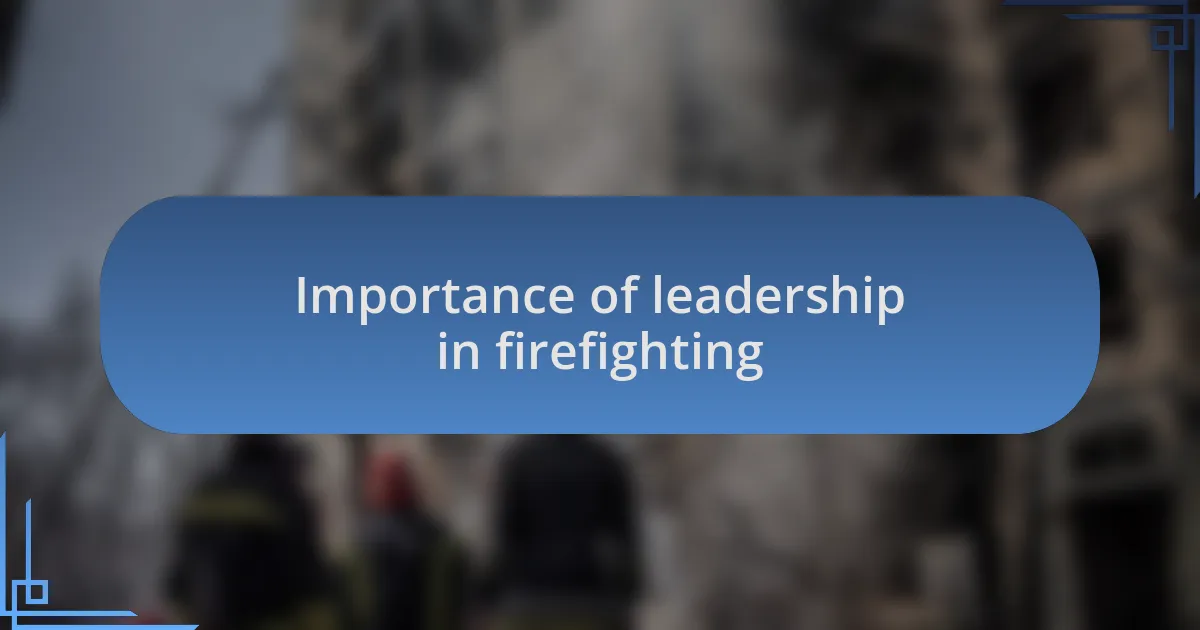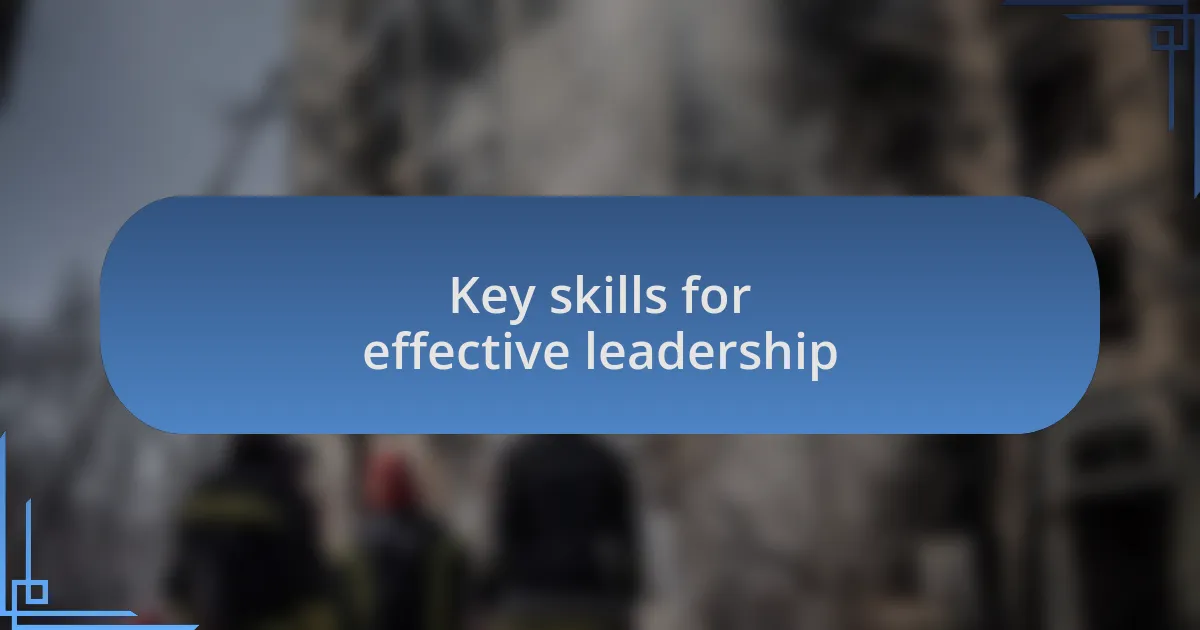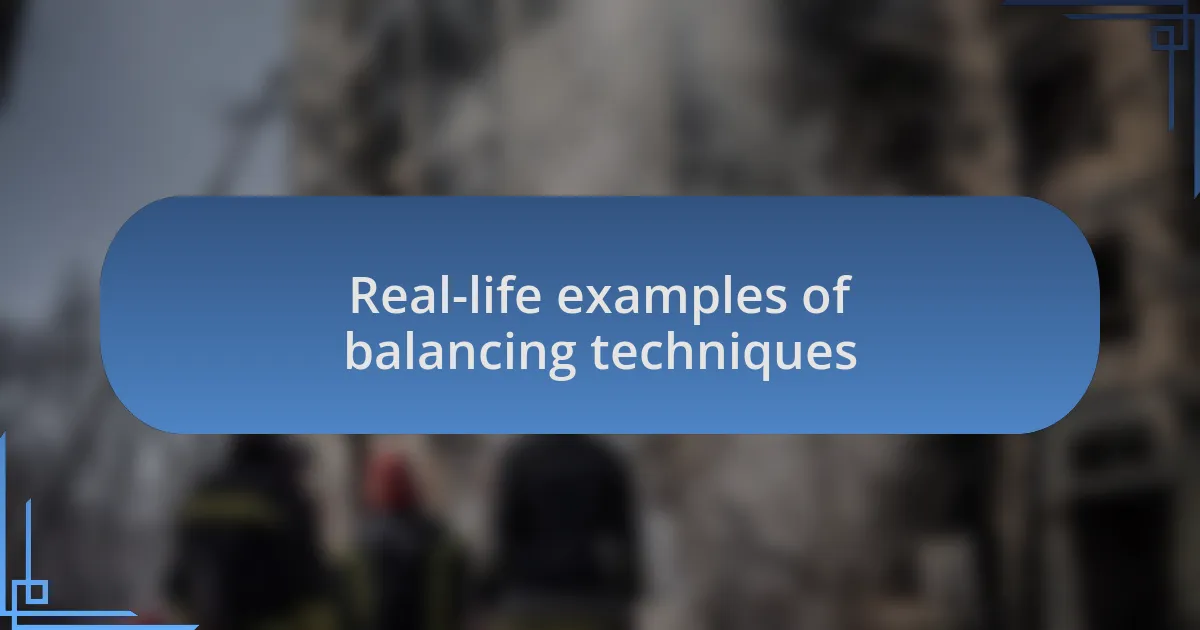Key takeaways:
- Effective leadership in firefighting enhances team morale, decision-making, and emotional support.
- Key leadership skills include clear communication, adaptability to changing situations, and emotional intelligence.
- Building trust involves open communication, consistency in actions, and sharing vulnerabilities.
- Empathy and approachability are crucial for balancing authority with team engagement and growth.

Importance of leadership in firefighting
Effective leadership is vital in firefighting, as it directly affects team morale and performance in high-pressure situations. I’ve witnessed firsthand the impact of a strong leader during a devastating blaze; their calm, authoritative presence inspired confidence in all team members, reminding us that unity and trust are our strongest tools.
When faced with life-or-death decisions, I often wonder: what differentiates a good leader from a great one in these moments? It’s not just about making the right calls but about fostering an environment where firefighters feel valued and heard. Leaders who actively seek input from their team not only enhance safety but also build a sense of belonging that ultimately strengthens the entire unit.
In my experience, compassionate leadership—forging connections with each team member—can be just as crucial as tactical competence. I’ve found that leaders who show genuine concern for their firefighters’ well-being create an atmosphere where everyone is motivated to give their best, especially when the stakes are high. After all, wouldn’t you want to follow someone who understands the challenges you face and stands alongside you every step of the way?

Key skills for effective leadership
Leadership in firefighting requires a unique blend of skills to truly be effective. For instance, I remember a time when our team was deployed to a massive forest fire. The incident commander not only communicated the strategy clearly but also listened to our concerns. That two-way communication fostered trust, ensuring everyone felt safe to voice their observations, which ultimately saved lives.
Another essential skill is adaptability. I’ve seen leaders thrive or struggle under shifting conditions—whether it’s a sudden change in wind direction or an unexpected structural collapse. A memorable incident involved a last-minute adjustment of our approach during a warehouse fire. The leader’s ability to make quick, smart decisions in the face of uncertainty kept us all focused and ready to respond effectively.
Emotional intelligence also plays a critical role in leadership. I vividly recall a debrief after a particularly harrowing call. The way our chief empathized with each of us, acknowledging our stress and fatigue, was a game-changer. His approach not only validated our feelings but also brought us closer as a team, reminding us that while we tackle flames, it’s equally important to care for each other’s emotional well-being.

Building trust with team members
Building trust within a firefighting team starts with open lines of communication. I recall a situation where we faced a challenging rescue operation. I made it a point to encourage everyone to share their thoughts and suggestions, no matter how small. This openness not only helped to formulate a solid plan but also made everyone feel valued, enhancing our overall trust in one another.
Then there’s the importance of consistency in action and decision-making. I’ve learned that when a leader follows through on promises, it inspires confidence. After a tense incident, I committed to a follow-up session that allowed us to discuss the outcomes and any lingering doubts. That consistency built a stronger foundation of trust, demonstrating I was there for my team, both in success and in reflecting on our challenges.
Finally, vulnerability plays a crucial role in forging trust among team members. I remember when I candidly shared my own fears after a particularly close call during training. It was a risk, but it opened up the floor to others to express their own concerns. This shared vulnerability fostered a genuine connection and solidified our bond, making it clear that it’s okay to lean on each other, especially in our high-stakes environment.

Real-life examples of balancing techniques
During a particularly intense training session, I noticed that a new recruit was struggling with a difficult drill. Instead of rebuking him for his mistakes, I approached him with a supportive tone, sharing my own experience of failing at that same drill when I first encountered it. How many times have we all felt overwhelmed in a high-pressure environment? That small moment of empathy not only eased his anxiety but also transformed him into an eager participant in the next drill, showcasing the delicate balance between authority and approachability.
I remember another instance where we were preparing for a community demonstration. In my role, I needed to assert the importance of following protocol while still allowing room for creativity. I took the time to facilitate a brainstorming session where everyone could contribute ideas, reinforcing that their input mattered. By encouraging this kind of collaboration, I found that the team felt empowered to take ownership of the project, which ultimately led to a successful event that showcased our skills and unity.
Reflecting on my experiences, there was a time when I needed to address an underperforming firefighter. Rather than delivering my feedback in a harsh manner, I chose to have a private conversation where I expressed my belief in his potential and shared constructive suggestions. Hasn’t every leader faced the challenge of delivering tough messages? By prioritizing approachability, I created an environment conducive to growth, turning what could have been a negative encounter into a pivotal moment for both of us.